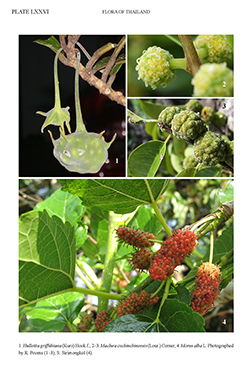e-Flora of Thailand
Volume 10 > Part 4 > Year 2011 > Page 657 > Moraceae > Morus
1. Morus alba L.wfo-0000447905
Sp. Pl.: 986. 1753; Seringe, Descr. Cult. Muriers; 19, t. 1–18. 1855; Bureau in DC., Prodr. 17: 238. 1973; C.C.Berg et al., Fl. Males., Ser. 1, Spermat. 17(1): 24. 2006. Plate LXXVI: 4.
Accepted Name : This is currently accepted.
Description : Tree to 10 (or more ?) m tall. Leafy twigs 2–4 mm thick, (minutely) white puberulous; resting buds ca 0.5 cm long. Leaves distichous; lamina ovate or subovate (in outline), 10–20 by 6–15 cm, entire or 3–9-lobate to -fid, apex acuminate, base truncate to subcordate, margin crenate- to serrate-dentate; upper surface minutely puberulous to hispidulous, scabridulous to smooth, lower surface puberulous to hispidulous on the (main) veins, with concentrations of hairs in the axils of lateral veins and furcations of lateral veins, scabridulous to smooth; lateral veins (3–)4–6(–7) pairs, the basal pair to ½(–⅔) the length of the lamina, branched, the other lateral veins also branched or forked away from the margin, tertiary venation loosely scalariform; petiole 1–6 cm long, 2–2.5 mm thick, minutely white puberulous; stipules 0.5–1.2 cm long, white puberulous, caducous. Staminate inflorescences axillary (often in the axils of scale leaves at the base of new shoots), solitary, spicate, ebracteate; peduncle 0.5–1.5 cm long, minutely white puberulous to tomentellous; spike 0.5–2 cm long; flowers ca 5–20, sessile or to 1.5 mm long pedicellate; perianth 1–2 mm long, minutely white puberulous, stamens 3–3.5 mm long, anthers ca 0.5 mm long. Pistillate inflorescences axillary (often in the axils of scale leaves at the base of new shoots), solitary (or in pairs), spicate to subcapitate, ebracteate; peduncle 0.5–1.5 cm long, white puberulous to tomentellous; spike 0.5–1.5 cm long; flowers numerous (ca. 15–50); tepals 1–1.5 mm long, sparsely white puberulous; ovary ca 1 mm long, style 0–1.5 mm long, stigmas 1.5–3.5 mm long. Infructescences 0.8–3.5 cm long, 0.5–1.5 cm thick, reddish to black.
Thailand : NORTHERN: Chiang Mai, Phitsanulok; NORTH-EASTERN: Loei (in cultivation).
Distribution : From Afghanistan through the Himalaya region to China and Japan, wild or cultivated. Introduced worldwide in temperate to tropical regions in connection with silk and or fruit production.
Vernacular : Mon (หม่อน).
Uses: This species is in cultivation for its fruits and for the silk industry.
Notes: Material with pistillate flowers which have long styles ca 1–1.5 mm long, has been identified as Morus australis Poir, and that with short, to ca 0.5 mm long styles as M. alba but, as this weak difference cannot be correlated to clear differences in staminate flowers and vegetative parts, only M. alba is recognized. The long-styled form can be indicated as M. alba L. var. indica (L.) Bur., however.
For reasons of poorly understood taxonomy, the effects of cultivation over a long period of time, and nomenclatural complexity, synonymizing is not attempted in the present treatment of Morus alba.

